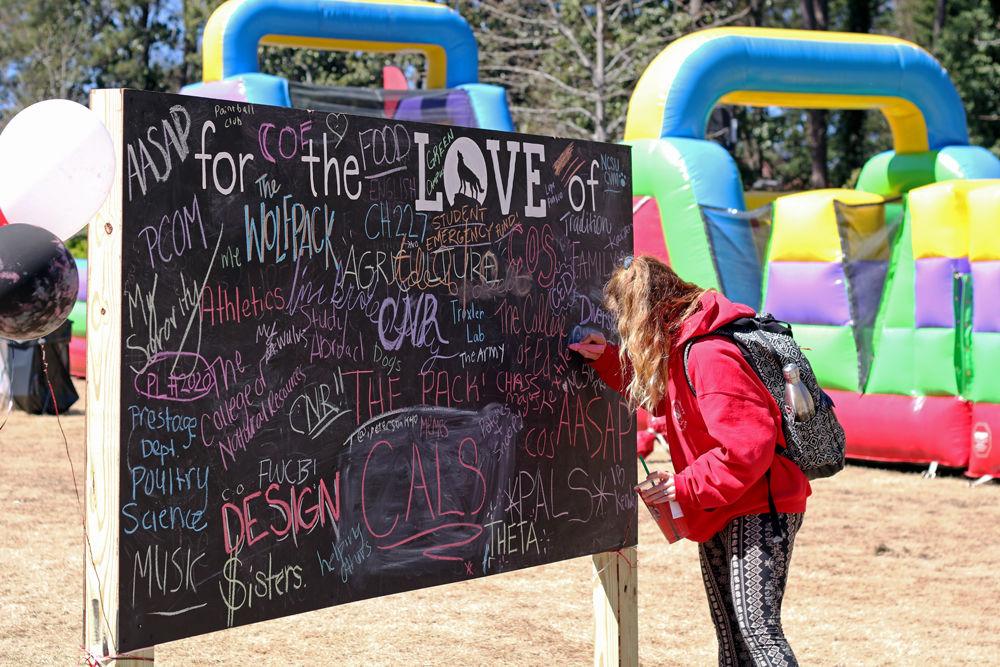While some students chose to avoid participating or to be selective with their donations during NC State Student Giving Day on Wednesday, over $13.5 million was raised with a total of 10,810 gifts to various areas on campus within one day.
During the 24-hour giving period, students, faculty, staff and alumni had the opportunity to give to all individual colleges, the Division of Academic and Student Affairs, NCSU Libraries or several other campus programs. Of the funds people were able to donate, a majority were current-use funds, meaning they would be used for immediate impact, rather than funds pertaining to long-term scholarships or endowments.
On giving day, several student organizations on campus such as the Climate Reality Project, Young Democratic Socialists of America, NAACP and the Native American Student Association worked to spread awareness about donating to the university and educate students about the different places their contributions could be allocated within the endowment fund, which has been under recent scrutiny.
NC State invests approximately $1 billion in what is known as the NC State Investment Fund, which is largely run by the UNC Management Company. Over $43 million of the fund is invested in fossil fuels.
According to an email from NC State Day of Giving, the funds displayed on the site that are not current use funds and thus invested are: the College of Education Student Scholarship Endowment, Black Alumni Society Clark Memorial Undergraduate Scholarship, Park Scholarships Sustaining Endowment, Our Three Winners Scholarship Endowment, NC State Employee Dependent’s Tuition Scholarship.
Meredith Bain, a fourth-year studying mathematics and German and president of the Climate Reality Project, said that student organizations set up tables in several different places around campus to educate students about NC State’s Investment Fund.
“It’s not our purpose to take any resources away from the university,” Bain said. “We just want to prevent resources from going to fossil fuel investments. If there’s a way the university can get money without supporting this huge ethical problem they have, that doesn’t conflict with our goals.”
Bain said she hopes that soon, the investments the university makes will have positive impacts on the state without putting funds into the fossil fuel industry. She also said that she hopes the initiative will be the beginning of transparency from the university regarding investments.
“We don’t want to just do this and scream into the void,” Bain said. “We want to do this and be a continuation of a conversation, maybe a turning point of the conversation, where we can finally begin to collaborate with the university, where they’ll take our concerns about the endowment seriously.”
Noah Riley, a fourth-year studying biological sciences, echoed Bain’s sentiments about students’ right to know where the money paid to the endowment fund would go.
“The university is asking students for money — asking poor students for money — and with people already strapped for cash, you really need to know where your money is going,” Riley said. “I think students should definitely be aware of where their money is going and where the university’s values really are.”
Outside of organizations advocating for more awareness about university funds and investments, some students chose not to participate. Jokes were even displayed on the “NC State Memes for Thinking and Doing Teens” Facebook page about giving day taking from students who already pay so much to the university that got over 200 engagements.
Iman Usmani, a fourth-year studying statistics and member of the Climate Reality Project, said that she hopes students will consider giving to other areas on campus where their money will not be invested in the fossil fuel industry.
“I hope that students don’t give toward the endowment fund, to be honest,” Usmani said. “I hope it just goes towards those current use funds that we were talking about and towards the Women’s Center and the GLBT Center, because those are the places that need the money now, and we also know it’s not going into the fossil fuel industry.”
Kara Mulligan, assistant director of annual giving, said that students have chosen to support several initiatives on campus such as the Student Emergency Fund or financial aid. Mulligan said that certain funds given to the university are current use funds that will be used within the year.
“All of the college excellence funds as well as financial aid and the Student Emergency Fund, we go through those dollars within the year,” Mulligan said. “Those are quick in-and-out gifts. Especially the Student Emergency Fund; those are awarded almost on a weekly basis.”
Ellison Lambert, a fourth-year in parks, recreation and tourism and president of Students for University Advancement, said that most students who chose to participate decided to donate to their respective colleges.
“I think it’s been cool to see how diverse the different options are that people have been choosing to donate to,” Lambert said. “Pretty much every college has a general fund, but then all of the colleges have individual funds too, so it’s been interesting to learn what funds there are and what people want to donate to.”
Mulligan and Lambert said they were not able to comment on the endowment fund and students actions taken in protest of the fund.
Mulligan said that ultimately, the goal of the event was to see students get involved in the culture of giving back to programs that can make a large impact students on campus.
“I think that we want students to know that philanthropy can be fun,” Mulligan said. “Also, that we really do believe that no one is making huge hundred-dollar gifts, but when we are able to give small gifts as a large group, it’s really just proof that small gifts can make a large impact.”








